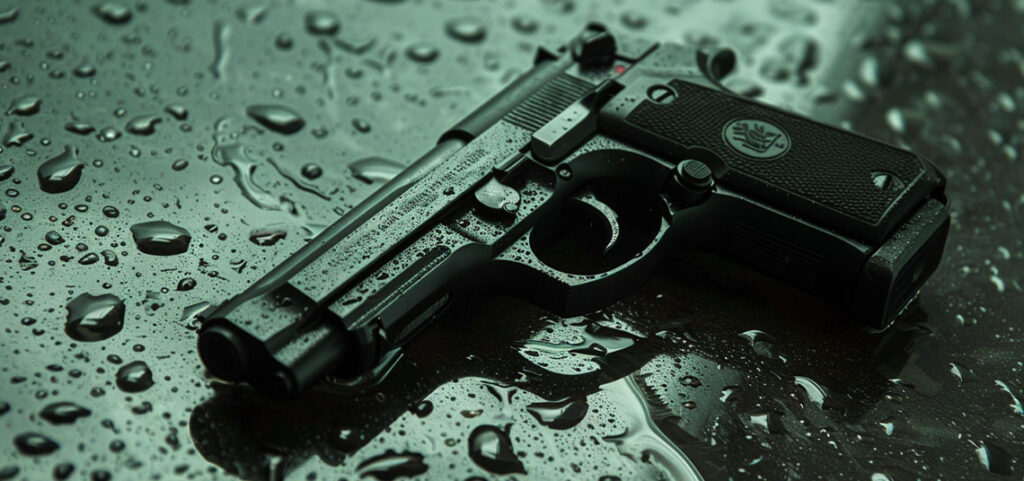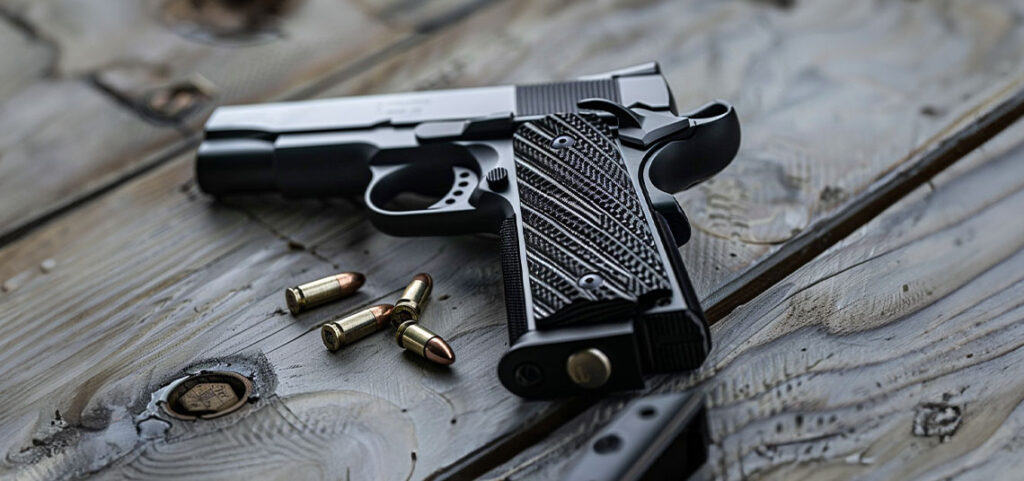Cleaning Handgun : 5 Essential Tips for Flawless Functionality
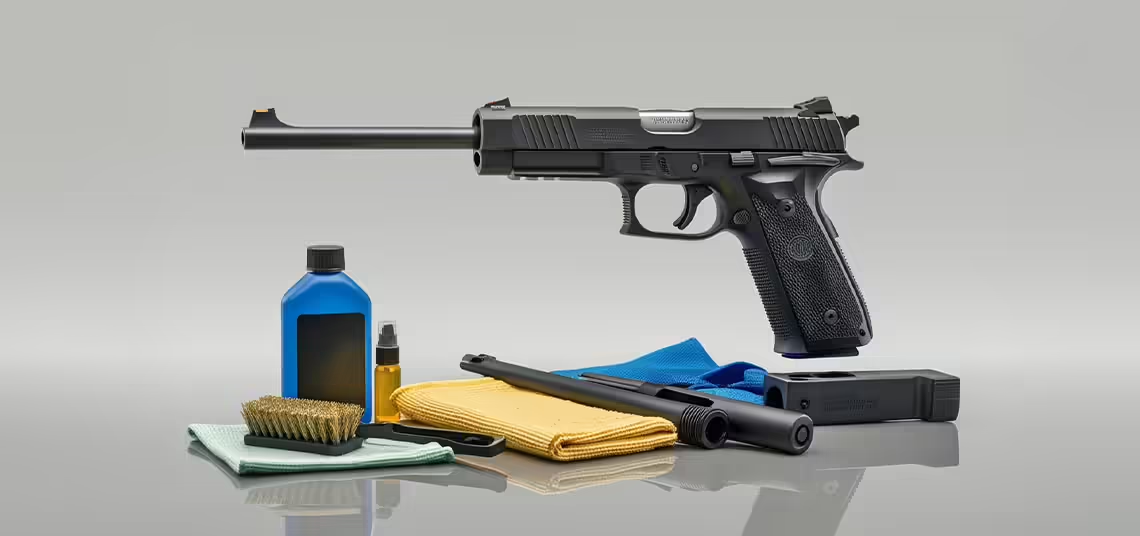
Cleaning handgun is one of the most crucial maintenance tasks for ensuring its performance and safety. Without regular care, a handgun can suffer from performance degradation, wear, and even malfunctions over time. Utilizing the right techniques and proper products during the handgun cleaning process not only helps prolong the firearm’s life but also enhances shooting accuracy and reliability. By adhering to specific steps and important tips during cleaning, one can achieve both efficient cleaning and protect the handgun from damage.
Why is Cleaning a Handgun Important?
Cleaning a handgun plays a vital role in its reliability, performance, and long-term use. Handguns that are not cleaned regularly can experience decreased shooting accuracy, malfunctions, and safety risks over time. Due to their working principles, firearms accumulate powder, oil, and metal residues during use. If not cleaned properly, these residues can negatively impact both the mechanical functioning and the overall performance of the weapon. Therefore, proper handgun cleaning not only preserves the reliability of the firearm but also ensures that it performs correctly for the user under all circumstances.
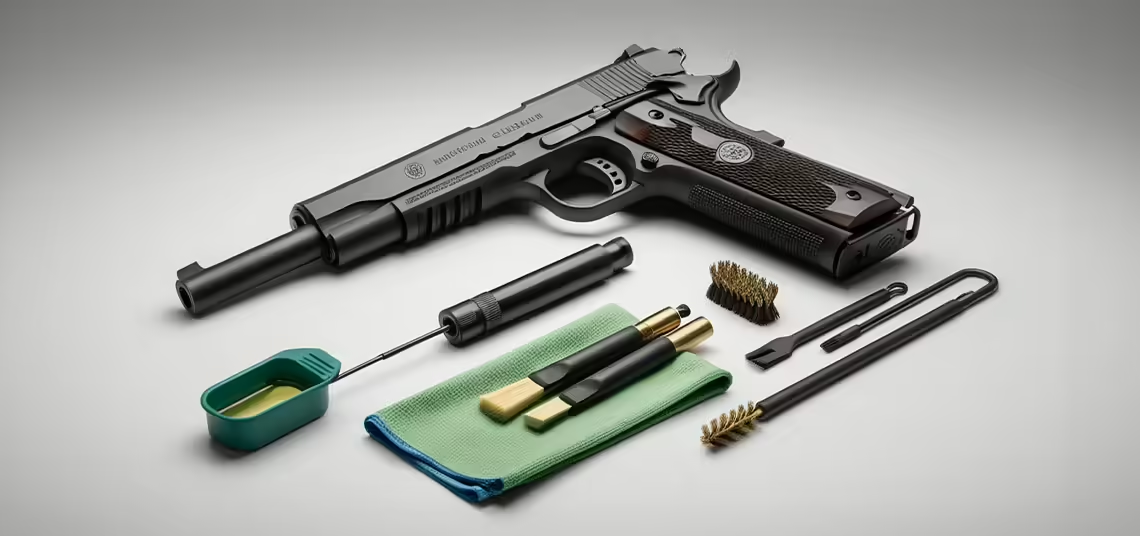
Handgun Performance and Accuracy
The performance and accuracy of a handgun depend on a clean mechanism and a well-maintained barrel. The process of cleaning a handgun removes residues from the barrel, slide, trigger, and other moving parts, enabling the firearm to function with optimal accuracy and precision. Powder residues, when accumulated inside the barrel, can interfere with the bullet’s path and reduce the accuracy of shots. Additionally, such residues may slow down or jam the firearm’s mechanism, lowering its reliability during use.
Regular cleaning helps better control the heat generated during firing and removes burnt powder residues that may damage the barrel. A clean handgun consistently delivers reliable performance and allows for more accurate shots on target. To maintain performance and accuracy, cleaning the handgun with appropriate materials and techniques is essential.
Ensuring Safety and Longevity
Cleaning a handgun is one of the most important steps in ensuring the safe operation of the firearm. A dirty handgun can experience jamming in the firing mechanism, misfires, or even dangerous malfunctions, posing significant safety risks to the user. Regular cleaning and maintenance help ensure the safe operation of the firearm and give the user peace of mind over time.
Additionally, for the handgun to remain long-lasting and always deliver optimal performance, regular cleaning is crucial. Accumulated dust, powder, and oil residues on the internal parts of the firearm can cause wear over time. This wear not only shortens the lifespan of the firearm but can also decrease its value. A clean handgun ensures smooth operation and helps maintain the firearm’s initial performance for years.
Proper and regular cleaning not only preserves the performance and safety of the handgun but also minimizes wear, extending the weapon’s life. Therefore, cleaning a handgun is not just a maintenance activity but a necessity for ensuring safety and effective firearm operation.
Preparing for Cleaning a Handgun
Proper preparation before beginning the cleaning process is key to ensuring both an effective and safe cleaning session. Having the necessary equipment ready and being aware of the safety precautions to follow during cleaning are critical to successfully cleaning the handgun. Proper preparation with the right materials and safety measures aids in making the cleaning process more effective and reliable. The quality of the products used in this stage and the correct application methods help maintain the performance of the handgun while also extending its service life.
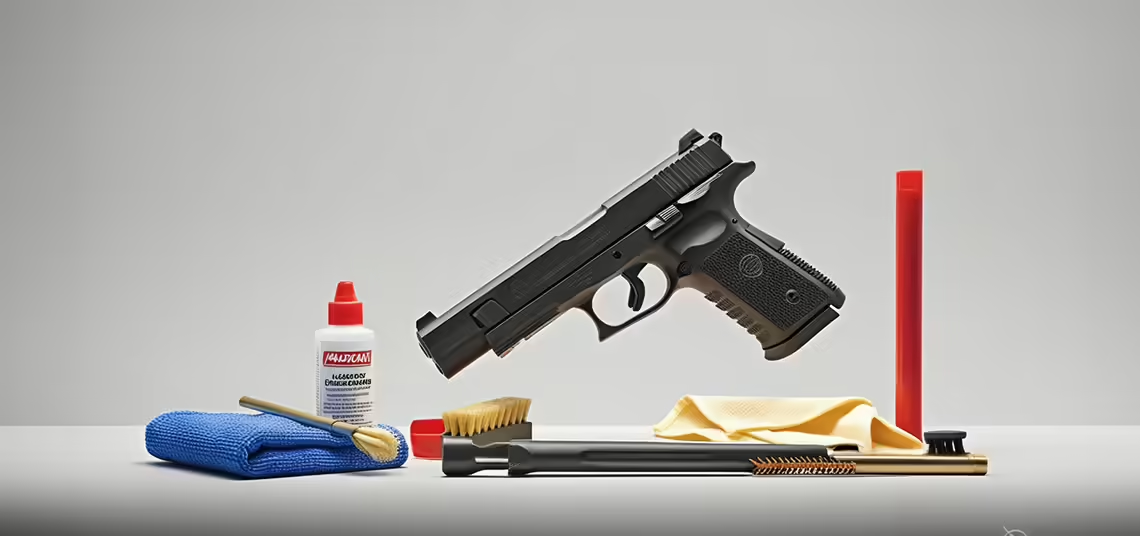
Essential Materials for Cleaning
Selecting the right materials for cleaning a handgun ensures efficient and safe maintenance. Each piece of equipment and cleaning product has a specific purpose that simplifies the process. Here are the essential materials required for cleaning a handgun:
- Handgun Cleaning Kit: Specialized cleaning kits designed for handguns include brushes of different diameters and lengths, cleaning rods, and cloths. It is recommended to use a cleaning kit suited to your specific handgun model.
- Cleaning Brushes and Rods: Various sizes and types of brushes are required to clean the barrel, slide, and other components of the handgun. These brushes remove residues and deposits from the surface of the firearm. Cleaning rods are perfect for scrubbing the inside of the barrel.
- Cleaning Solution: Cleaning solutions dissolve powder, oil, and dirt residues on the handgun. Specially formulated solutions for firearm cleaning provide thorough cleaning without causing any abrasive or damaging effects.
- Lubricants: After cleaning, lubricants are used to reduce friction between the handgun’s parts, allowing for smoother operation. Lubricants also minimize wear and extend the lifespan of mechanical parts. It is important to use a lubricant appropriate for your specific handgun.
- Microfiber Cleaning Cloth: Microfiber cloths are used to remove excess cleaning solution from the handgun’s surface and to dry its components. These cloths clean and polish the surface without scratching.
- Gloves and Protective Glasses: The solvents and lubricants used during cleaning can irritate the skin. Therefore, it is recommended to wear gloves during cleaning. Additionally, protective glasses should be worn when cleaning the barrel and other parts.
These materials are necessary for efficient and safe handgun cleaning. Proper use of each material facilitates cleaning while preserving the handgun’s performance and extending its service life.
Safety Precautions for Cleaning
Safety precautions during handgun cleaning are critical to protect both the user and those around them. Cleaning a handgun involves disassembling many parts of the firearm and conducting a detailed cleaning process, which requires caution at all times. Here are the basic safety precautions to take before starting the cleaning process:
- Ensure the Handgun is Unloaded: Before starting the cleaning process, remove the magazine and ensure that there is no round in the chamber. Only start the cleaning process once you are sure that the handgun is completely empty.
- Choose an Appropriate Cleaning Area: Perform the cleaning process in a quiet, distraction-free area. Any distractions during the process can lead to mistakes and pose safety risks. Also, make sure the area is well-ventilated to minimize exposure to solvent fumes.
- Wear Proper Clothing and Protective Gear: The chemicals used during cleaning can cause skin and eye irritation. Therefore, protect yourself by using gloves and glasses. Additionally, wearing long-sleeved clothing will help shield your skin from potential splashes or spills.
- Keep Your Work Area Organized: Organizing the brushes, solutions, rods, and other equipment used for cleaning helps facilitate the process and prevents potential accidents. A messy area may lead to accidental drops or loss of materials.
- Carefully Disassemble and Reassemble: When disassembling the handgun for cleaning, carefully remove each component and place them systematically to prevent loss. During reassembly, ensure that the parts are assembled in the correct order and securely.
Adhering to these safety precautions ensures that the cleaning process is conducted securely, effectively, and without complications. Ignoring safety principles can result in damaging the firearm or injury during cleaning.
Key Considerations for Cleaning a Handgun
Cleaning a handgun is a meticulous process that should be carried out carefully to ensure that the firearm operates reliably and accurately. Properly conducting each step of the cleaning process helps maintain the handgun’s performance, prevent wear, and provide a safer experience. Following a systematic and thorough cleaning sequence, including disassembling the firearm, cleaning the barrel, and reassembling it properly, ensures the handgun remains long-lasting and safe to use. Here are some critical steps to keep in mind.
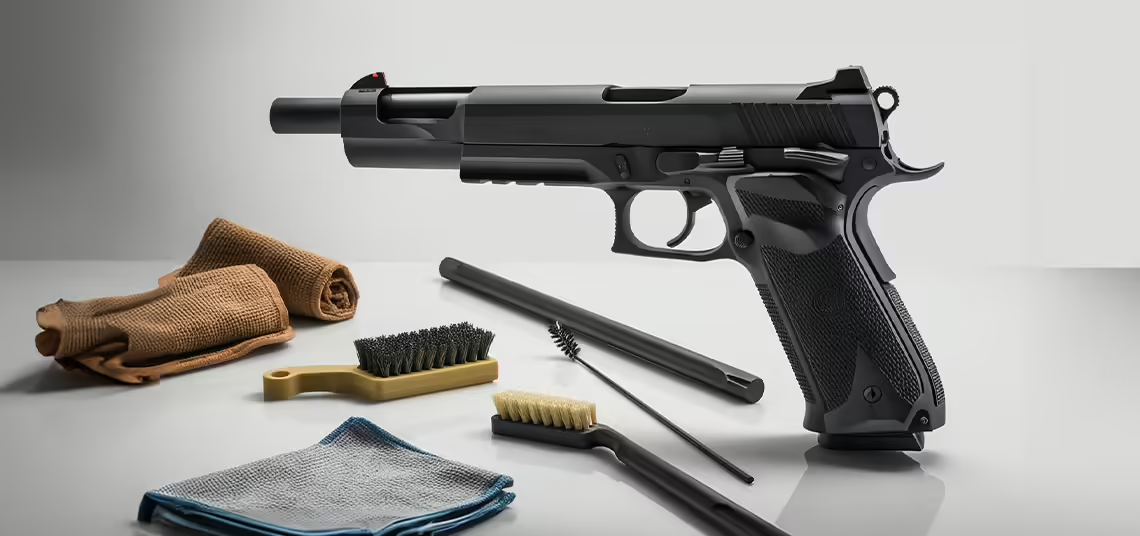
Properly Disassembling and Cleaning Sequence
Correctly disassembling the handgun during cleaning ensures efficient cleaning and prevents damage to the firearm. Improper or incorrect disassembly can lead to damage to internal components and ineffective cleaning. Before disassembling the firearm, the cleaning area should be well-organized, and each part should be cleaned separately in a specific order.
- Disassembling the Handgun: The first step in cleaning a handgun is to safely unload the firearm and ensure it is completely empty. Then, depending on the handgun model, remove the slide, barrel, magazine, trigger assembly, and other moving parts. Follow the user manual to confirm that all parts are disassembled in the correct order and manner.
- Cleaning Sequence: When cleaning a handgun, the parts should be cleaned in the correct sequence. Generally, the barrel and its surrounding area are cleaned first as they are the most critical components and require thorough cleaning. Then, clean the slide, firing mechanism, and trigger system. Finally, clean and lubricate the frame and magazine. Following this order ensures effective cleaning and that all parts are cleaned properly.
- Using the Correct Tools: During cleaning, use suitable rods, brushes, and cloths. Brushes should be of the correct size and material for the handgun’s components. Soft-bristled brushes are especially recommended for sensitive parts. Additionally, cleaning rods should be designed to avoid damaging the barrel’s interior surface.
- Cleaning Each Part Individually: Cleaning each part of the handgun separately allows for deep cleaning. During cleaning, make sure to remove all oil, dirt, and powder residues from each part, and dry them thoroughly before reassembly.
Cleaning a handgun systematically and correctly preserves its performance, prevents wear, and contributes to safer operation. Each part of the firearm should be carefully cleaned, lubricated, and assembled in the correct sequence.
Best Practices for Cleaning the Barrel
Cleaning the barrel is one of the most crucial steps in the handgun cleaning process. Properly cleaning the barrel helps maintain the firearm’s accuracy and reduces mechanical wear. The barrel, being the part most exposed to powder gases and metal debris during shooting, requires special attention during cleaning.
- Cleaning the Interior of the Barrel: Use specialized cleaning rods and appropriately stiff brushes to clean the interior of the barrel. To avoid damaging the barrel during cleaning, opt for soft-bristled brushes, and gently clean any build-up. Apply a cleaning solution or solvent to the barrel to soften the residues and then clean it with a brush.
- Cleaning the Exterior of the Barrel: In addition to the interior, the exterior of the barrel should also be cleaned carefully. Remove any accumulated oil, dust, and powder residues from the exterior and protect it with light lubricants. Avoid using harsh brushes or abrasive cleaning materials during exterior cleaning, as these may scratch the barrel surface.
- Single-Direction Movement During Barrel Cleaning: When cleaning the barrel, use single-direction movements with the brush or cleaning rod. This makes it easier to remove residues and minimizes wear on the barrel surface. Instead of back-and-forth movements, cleaning in a single direction along the barrel helps maintain a smooth interior surface.
- Drying and Lubrication: After cleaning, dry the barrel using a clean cloth or a soft cleaning pad. Keeping the barrel dry prevents rust. After drying, apply a small amount of gun oil in a thin layer to the interior surface of the barrel. This lubrication protects the barrel’s metal surface and reduces friction during future use.
Cleaning the barrel is one of the most important steps in the handgun cleaning process. When done correctly, it improves firearm performance and prevents wear and corrosion. Regular barrel cleaning is recommended to maintain the reliability and accuracy of the firearm.
Proper Use of Cleaning Products for Handgun
The quality and correct use of cleaning products during handgun cleaning directly affect the firearm’s performance and durability. For the cleaning process to be successful, it is crucial to select the appropriate products and use them correctly. Lubricants, cleaning solutions, and brushes play a critical role in the firearm’s care and cleaning process. Incorrect product use can damage the mechanical components of the handgun, result in ineffective cleaning, or accelerate wear. Thus, understanding the properties and correct usage of cleaning products is vital for maintaining the performance and life of the firearm.
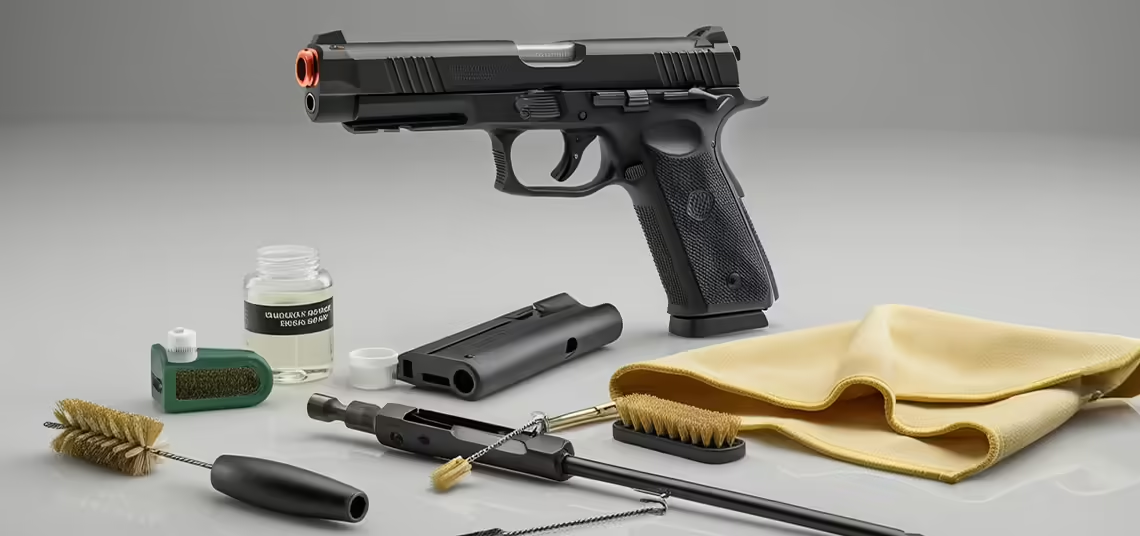
Using Lubricants and Cleaning Solutions Properly
Lubricants and cleaning solutions are among the most important materials for cleaning handguns. These products clean, protect, and ensure proper functioning of the firearm’s mechanical components. Cleaning solutions formulated specifically for firearms dissolve powder, metal, and oil residues from the surface, allowing for thorough cleaning.
- Proper Use of Cleaning Solutions: Using cleaning solutions correctly during the handgun cleaning process is very important. Apply the solution to parts most exposed to dirt accumulation, such as the barrel, slide, and firing mechanism. Allow the solution to sit for a while to soften the build-up, then clean gently with a brush. Avoid over-application and make sure all parts are thoroughly wiped clean of any solution residue, as residues may damage metal surfaces or alter part structures.
- Proper Use of Lubricants: Lubricants in the cleaning process help ensure that the handgun’s parts function correctly. They reduce friction between mechanical parts, prevent wear, and protect against rust. The key point during lubrication is applying the oil only to necessary areas in appropriate quantities. Excess oil can accumulate between parts and affect the firearm’s movement. A thin layer of oil should be applied to lubrication points specified in the handgun’s manual.
- Choosing the Right Lubricants and Solutions: The quality of the lubricant and solution used for cleaning is also important. Opt for cleaning solutions and lubricants formulated specifically for firearm care. Products that are non-abrasive and have protective features safeguard the metal surface of the handgun and ensure long-lasting use.
Using lubricants and cleaning solutions correctly helps ensure that all mechanical parts of the handgun operate smoothly and are protected against wear. Regular use of these products enhances the handgun cleaning process and helps maintain its performance.
Selecting and Using Appropriate Cleaning Brushes
Brushes used in handgun cleaning are essential for removing build-up and residues. Using brushes appropriate for the handgun model and its parts improves the cleaning process’s effectiveness and ensures the surface is cleaned without damage. The selection and use of brushes minimize cleaning challenges and facilitate efficient cleaning.
- Selecting the Right Brush Types: The most commonly used brushes for handgun cleaning are brass, nylon, and soft-bristled brushes. Brass Brushes are effective for cleaning heavy residues inside the barrel. While these brushes are suitable for removing tough dirt, they should be used carefully on sensitive surfaces. Nylon Brushes are designed for use on more delicate firearm parts and are ideal for removing light dirt. Soft-Bristled Brushes are used in the final cleaning step to polish and give the handgun’s surface a final clean.
- Proper Use of Brushes: Brushes used during cleaning should match the length and thickness appropriate to the handgun model. Correctly sized brushes improve the cleaning process’s efficiency and ensure that parts are cleaned without damage. During barrel cleaning, make sure to choose a brush suitable for the barrel’s diameter. Brushes should be used gently in a single direction over the dirty surface to make it easier to remove build-up and prevent scratching the metal surface.
- Brush Maintenance and Cleaning: The brushes used during cleaning should also be maintained properly. After cleaning, wash the brushes thoroughly to remove residues and dry them. Also, the bristles of the brushes may become deformed over time, so they should be checked regularly, and worn brushes should be replaced.
Selecting the right brushes for handgun cleaning and using them correctly facilitate efficient cleaning and help maintain the mechanical components of the firearm during the process.
Regular Handgun Cleaning and Maintenance Tips
Regular handgun cleaning and maintenance are the most effective ways to preserve the firearm’s performance and longevity. Every handgun should be cleaned and maintained at regular intervals based on its frequency of use and the conditions it is exposed to. Cleaning helps the firearm function properly while also preventing wear and build-up. When conducted properly, regular maintenance keeps the handgun performing at its best and prevents potential malfunctions or accidents.
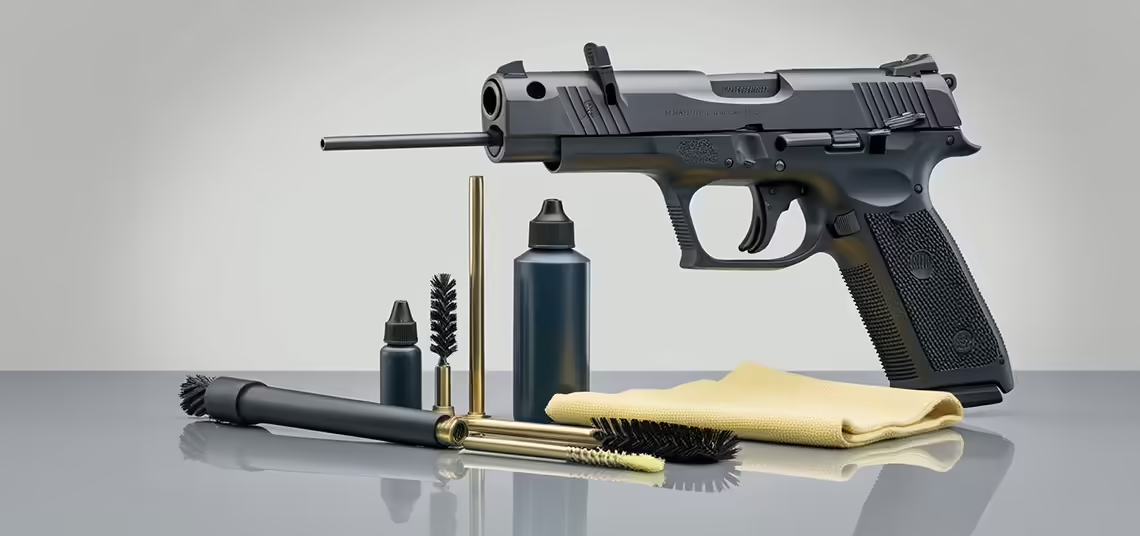
Frequency of Cleaning and Maintenance
The frequency of handgun cleaning and maintenance depends on how often the firearm is used, the environmental conditions, and the type of handgun. However, it is recommended to clean and maintain the firearm after every use and at regular intervals. Regular cleaning and maintenance preserve the handgun’s long-term reliability and ensure it is always ready for use.
- Cleaning Based on Usage Frequency: If a handgun is used regularly, it should be cleaned after every shooting session or after a certain number of rounds. This helps remove build-up from the barrel and other mechanical parts, keeping the firearm functioning properly. For example, a frequently used handgun should undergo a thorough cleaning every 300-500 rounds. Less frequently used handguns should be inspected and cleaned every few months.
- Cleaning Based on Environmental Conditions: The frequency of handgun cleaning also depends on the conditions in which it is used. Firearms exposed to humid, dusty, or dirty environments should be cleaned more frequently. These conditions can lead to rust, build-up, and wear on the internal and external surfaces of the firearm. Therefore, cleaning firearms used in such conditions should not be neglected.
- Maintenance for Handguns Stored for Long Periods: If a handgun is to be stored for an extended period without use, special attention should be given to its cleaning and maintenance. Before storage, all parts of the firearm should be cleaned, dried, and lightly lubricated to protect against moisture and rust. Storing the handgun in a suitable case or container and conducting regular checks will help preserve the firearm.
Regular maintenance and cleaning keep the mechanical parts of the handgun functioning smoothly and ensure reliable performance over time. Thus, handgun cleaning should become a routine process and be performed at regular intervals based on usage.
Inspection and Testing After Cleaning
After cleaning a handgun, it is crucial to ensure that all parts are functioning correctly and that the cleaning process was effective. Post-cleaning inspections and tests help verify the safe and efficient operation of the firearm and aid in identifying potential issues.
- Proper Assembly of Parts: After cleaning, assembling the handgun’s parts correctly is critical for smooth operation. Ensure each part is placed in its correct position and securely assembled. The slide, barrel, firing mechanism, and other moving parts should be properly fitted according to the firearm model. Incorrectly assembled parts can hinder the firearm’s operation or cause damage.
- Function Test: After cleaning and assembly, a function test should be performed. This test checks that the slide moves smoothly, the trigger mechanism works correctly, and the safety mechanisms are operational. Use dummy rounds during the function test, ensuring the handgun is safely unloaded. Ensure the slide, trigger, magazine, and other components operate correctly.
- Barrel Inspection and Post-Cleaning Check: The barrel, which requires special attention during cleaning, should be inspected after cleaning. Carefully examine the interior of the barrel for any residues, scratches, or damage. Use a light to check the barrel’s interior and confirm the cleaning was effective. A clean, smooth, and shiny barrel surface ensures optimal firearm performance during shooting.
- Test Shooting: If possible, conduct a test shooting session after cleaning and maintenance to evaluate the firearm’s performance. Test shooting confirms the accuracy, correct mechanism operation, and proper assembly of all components. Ensuring smooth operation during the test verifies that the cleaning process was successfully completed.
Inspections and tests performed after handgun cleaning help ensure safe and effective firearm use. These steps are an integral part of the cleaning and maintenance process and should be carried out regularly to preserve the handgun’s long-term performance.
Cleaning and maintaining a handgun are essential steps in ensuring safe, effective, and long-lasting use. Regular cleaning sessions, the use of appropriate products, and thorough inspections after cleaning help keep the firearm performing at its best. To learn more about proper maintenance and care for your firearm, you can visit zibgrips.com.
Zibgrips offers all the information needed for firearm care and cleaning, along with a comprehensive range of maintenance products and accessories. For detailed information or to get in touch, visit the contact page on their website, where you can reach their expert team for professional support on the right products and techniques.

